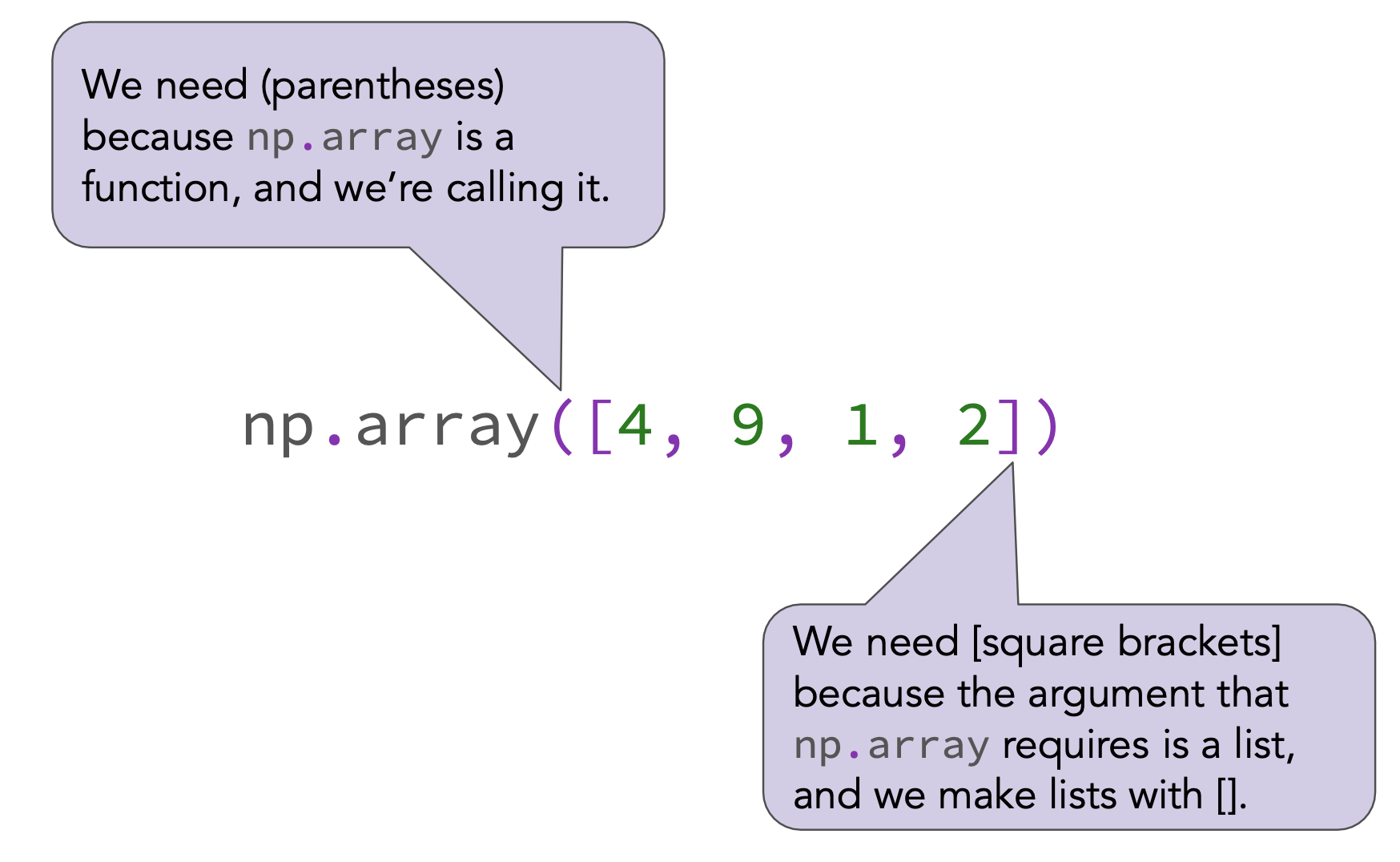Announcements¶
- Lab 0 is due tonight at 11:59PM.
import otterissues: Datahub instance not fully set up yet- For now, run
!pip install otter-grader
- Lab 1 is due Monday at 11:59PM.
- Work ahead so assignments don't pile up!
- Lab session after class today at 1:30PM
- The solutions to the pretest are now posted. See how you did and watch the 🎥 video at the end to learn more about important test-taking skills.
- Come to office hours (see the schedule here) and post on Ed for help!
Quiz¶
- The first quiz is Wednesday, July 10, in exactly one week.
- This will be a 20 minute paper-based quiz consisting of short answer and multiple choice questions.
- No aids are allowed (no notes, no calculators, no computers, no reference sheet). Questions are designed with this in mind.
- The quiz covers Lectures 1 through 4, or BPD 1-9 in the
babypandasnotes. - Review both of these materials to study.
- Attend discussion section next Tuesday to work on practice problems.
- Homework 1 is due Wednesday also, but working on the homework is excellent preparation for the quiz.
Resources 🤝¶
- We're covering a lot of content very quickly. If you're overwhelmed, just know that we're here to support you!
- Ed and office hours are your friends!
- Check the Resources tab of the course website for programming resources.
Agenda¶
- Strings. 🧶
- Means and medians.
- Lists.
- Arrays.
Strings 🧶¶
Strings 🧶¶
- A string is a snippet of text of any length.
- In Python, strings are enclosed by either single quotes or double quotes (doesn't matter which!)
'woof'
'woof'
type('woof')
str
"woof 🐶🐶"
'woof 🐶🐶'
# A string, not an int!
"1998" + "45"
'199845'
String arithmetic¶
When using the + symbol between two strings, the operation is called "concatenation".
s1 = 'baby'
s2 = '🐼'
s1 + s2
'baby🐼'
s1 + ' ' + s2
'baby 🐼'
s1 * 3 # multiplication is repeated addition, same as s1 + s1 + s1
'babybabybaby'
my_cool_string = 'data science is super cool!'
my_cool_string.title()
'Data Science Is Super Cool!'
my_cool_string.upper()
'DATA SCIENCE IS SUPER COOL!'
my_cool_string.replace('super cool', '💯' * 3)
'data science is 💯💯💯!'
"hello".upper()
'HELLO'
# len is not a method, since it doesn't use dot notation.
len(my_cool_string)
27
Type conversion to and from strings¶
- Any value can be converted to a string using
str. - Some strings can be converted to
intandfloat.
Type notes here
str(3)
'3'
float('3')
3.0
int('4')
4
int('baby panda')
--------------------------------------------------------------------------- ValueError Traceback (most recent call last) Cell In[18], line 1 ----> 1 int('baby panda') ValueError: invalid literal for int() with base 10: 'baby panda'
int('')
--------------------------------------------------------------------------- ValueError Traceback (most recent call last) Cell In[19], line 1 ----> 1 int('') ValueError: invalid literal for int() with base 10: ''
Concept Check ✅ – Answer at cc.dsc10.com¶
Assume you have run the following statements:
x = 3
y = '4'
z = '5.6'
Choose the expression that will be evaluated without an error.
A. x + y
B. x + int(y + z)
C. str(x) + int(y)
D. str(x) + z
E. All of them have errors
x = 3
y = '4'
z = '5.6'
int('4.5')
--------------------------------------------------------------------------- ValueError Traceback (most recent call last) Cell In[21], line 1 ----> 1 int('4.5') ValueError: invalid literal for int() with base 10: '4.5'
Means and medians¶
Describing numerical data¶
- We now know how to store individual numbers (as
ints orfloats) and pieces of text (as strings). But we often we'll work with sequences, or ordered collections, of several data values.
- For any collection of numbers, say temperatures, it can be helpful to summarize the data by its mean (i.e. average) or median.
- Both mean and median are measures of central tendency – that is, they tell us roughly where the "center" of the data falls.
The mean (i.e. average)¶
The mean is a one-number summary of a collection of numbers.
For example, the mean of $1$, $4$, $7$, and $12$ is $\frac{1 + 4 + 7 + 12}{4} = 6$.
Observe that the mean:
- Doesn't have to be equal to one of the data points.
- Doesn't have to be an integer, even if all of the data points are integers.
- Is somewhere between the min and max, but not necessarily halfway between.
- Has the same units as the data.
The median¶
Like the mean, the median is a one-number summary of a collection of numbers.
- To calculate it, sort the data points and pick the number in the middle.
- If there are two middle numbers, we usually pick the number halfway between (i.e. the mean of the middle two).
- Example:
- $\text{Median}(1, 4, 7, 12, 32) = 7$
- $\text{Median}(1, 4, 7, 12) = 5.5$
Mean vs. median¶
- The mean and median of a dataset can be the same, but they don't need to be. They measure the center of a dataset in two different ways.
- Two different datasets can have the same mean without having the same median, and vice versa.
Activity¶
Find two different datasets that have the same mean and different medians.
Find two different datasets that have the same median and different means.
Find two different datasets that have the same median and the same mean.
Means and medians are just summaries; they don't tell the whole story about a dataset!

In a few weeks, we'll learn about how to visualize the distribution of a collection of numbers using a histogram.
These two distributions have different means but the same median!
Lists¶
Average temperature for a week¶
How would we store the temperatures for a week to compute the average temperature?
Our best solution right now is to create a separate variable for each day of the week.
temp_sunday = 68
temp_monday = 73
temp_tuesday = 70
temp_wednesday = 74
temp_thursday = 76
temp_friday = 72
temp_saturday = 74
This technically allows us to do things like compute the average temperature:
avg_temperature = 1/7 * (
temp_sunday
+ temp_monday
+ temp_tuesday
+ ...)
Imagine a whole month's data, or a whole year's data. It seems like we need a better solution.
Lists in Python¶
In Python, a list is used to store multiple values within a single value. To create a new list from scratch, we use [square brackets].
temperature_list = [68, 73, 70, 74, 76, 72, 74]
len(temperature_list)
7
Notice that the elements in a list don't need to be unique!
Lists make working with sequences easy!¶
To find the average temperature, we just need to divide the sum of the temperatures by the number of temperatures recorded:
temperature_list
[68, 73, 70, 74, 76, 72, 74]
sum(temperature_list) / len(temperature_list)
72.42857142857143
Types¶
The type of a list is... list.
temperature_list
[68, 73, 70, 74, 76, 72, 74]
type(temperature_list)
list
Within a list, you can store elements of different types.
mixed_list = [-2, 2.5, 'ucsd', [1, 3]]
mixed_list
[-2, 2.5, 'ucsd', [1, 3]]
There's a problem...¶
- Lists are very slow.
- This is not a big deal when there aren't many entries, but it's a big problem when there are millions or billions of entries.
Arrays¶
NumPy¶

NumPy (pronounced "num pie") is a Python library (module) that provides support for arrays and operations on them.
The
babypandaslibrary, which you will learn about soon, goes hand-in-hand with NumPy.- NumPy is used heavily in the real world.
To use
numpy, we need to import it. It's usually imported asnp(but doesn't have to be!)
import numpy as np # gives it a nickname for abbreviation
Arrays¶
Think of NumPy arrays (just "arrays" from now on) as fancy, faster lists.

To create an array, we pass a list as input to the np.array function.
np.array([4, 9, 1, 2])
array([4, 9, 1, 2])

temperature_array = np.array([68, 73, 70, 74, 76, 72, 74])
temperature_array
array([68, 73, 70, 74, 76, 72, 74])
temperature_list
[68, 73, 70, 74, 76, 72, 74]
# No square brackets, because temperature_list is already a list!
np.array(temperature_list)
array([68, 73, 70, 74, 76, 72, 74])
Positions¶
When people wait in line, each person has a position.

Similarly, each element of an array (and list) has a position.
Accessing elements by position¶
- Python, like most programming languages, is "0-indexed."
- This means that the position of the first element in an array is 0, not 1.
- One interpretation is that an element's position represents the number of elements in front of it.
- To access the element in array
arr_nameat positionpos, we use the syntaxarr_name[pos].
temperature_array
array([68, 73, 70, 74, 76, 72, 74])
# If a position is negative, count from the end!
temperature_array[-2]
72
Types¶
Earlier in the lecture, we saw that lists can store elements of multiple types.
nums_and_strings_lst = ['uc', 'sd', 1961, 3.14]
nums_and_strings_lst
['uc', 'sd', 1961, 3.14]
This is not true of arrays – all elements in an array must be of the same type.
# All elements are converted to strings!
np.array(nums_and_strings_lst)
array(['uc', 'sd', '1961', '3.14'], dtype='<U32')
Array-number arithmetic¶
Arrays make it easy to perform the same operation to every element. This behavior is formally known as "broadcasting".

temperature_array
array([68, 73, 70, 74, 76, 72, 74])
# Increase all temperatures by 3 degrees.
temperature_array + 3
array([71, 76, 73, 77, 79, 75, 77])
# Halve all temperatures.
temperature_array / 2
array([34. , 36.5, 35. , 37. , 38. , 36. , 37. ])
# Convert all temperatures to Celsius.
(5 / 9) * (temperature_array - 32)
array([20. , 22.77777778, 21.11111111, 23.33333333, 24.44444444,
22.22222222, 23.33333333])
Note: In none of the above cells did we actually modify temperature_array! Each of those expressions created a new array.
temperature_array
array([68, 73, 70, 74, 76, 72, 74])
To actually change temperature_array, we need to reassign it to a new array.
temperature_array = (5 / 9) * (temperature_array - 32)
# Now in Celsius!
temperature_array
array([20. , 22.77777778, 21.11111111, 23.33333333, 24.44444444,
22.22222222, 23.33333333])
Element-wise arithmetic¶
- We can apply arithmetic operations to multiple arrays, provided they have the same length.
- The result is computed element-wise, which means that the arithmetic operation is applied to one pair of elements from each array at a time.

a = np.array([4, 5, -1])
b = np.array([2, 3, 2])
a + b
array([6, 8, 1])
a / b
array([ 2. , 1.66666667, -0.5 ])
a ** 2 + b ** 2
array([20, 34, 5])
Summary, after the break¶
Summary¶
- Strings are used to store text. Enclose them in single or double quotes.
- Lists and arrays are used to store sequences.
- Arrays are faster and more convenient for numerical operations.
- Access elements by position, starting at position 0.
- Remember to refer to the resources from the start of lecture!
After the break¶
We'll learn more about arrays and we'll see how to use Python to work with real-world tabular data.